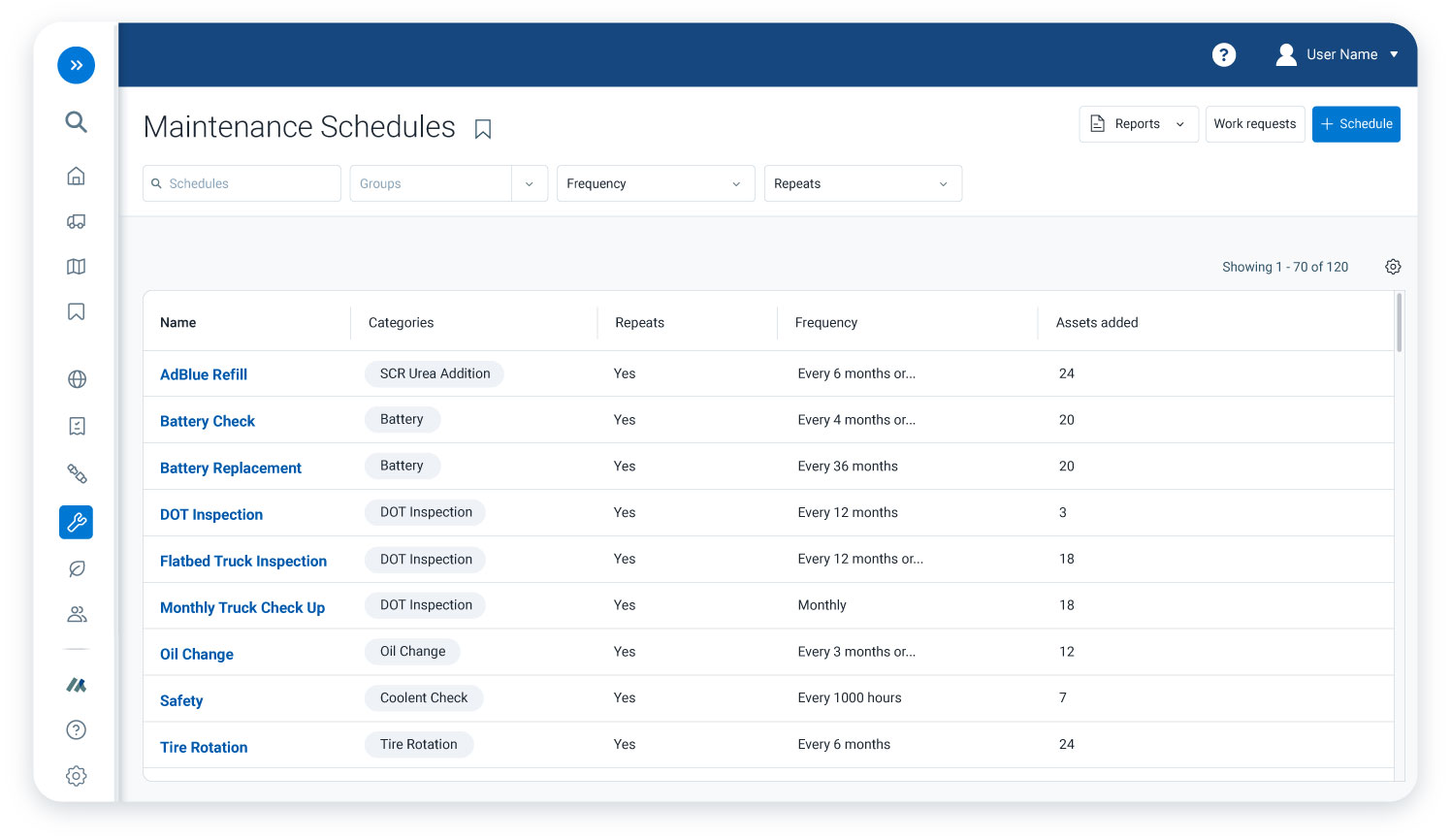Your ultimate back to school bus fleet operations checklist
Are you ready for the upcoming school year? Our detailed back to school checklist will help you prime your school bus fleet for success.

Aug 7, 2025

Key Insights
- Boost student safety by refining compliance processes, driver training, emergency response and communication before the school year starts
- Optimize your bus fleet with thorough inspections, proactive repairs, predictive maintenance and integration testing
- Align your budget with our cost-cutting insights to forecast and manage fleet expenses year-round
The new school year is quickly approaching. Are your school buses ready to roll safely, efficiently and within budget? Avoid last-minute guesswork with our comprehensive back-to-school student transportation checklist. We've packed it with actionable steps to help you ace operations in 2025-2026 and beyond.
Refining your school bus fleet safety protocols in advance
Student safety is the most important aspect of your operations. Make it your top back-to-school priority with these five steps, covering everything from emergency response to driver performance.
- Examine your compliance strategy: Compliance is your first defense, and driver inspections are crucial for flagging key bus safety issues. But if your manual inspection forms are often missing or incomplete, it’s time to go digital. Geotab's driver vehicle inspection reports (DVIRs) can seamlessly guide your drivers through electronic pre- and post-trip inspections, saving time and simplifying compliance.
- Make sure your drivers are well-trained: Ensure drivers are expertly trained in safe driving and incident management, from first aid to on-road risks. Always keep them up-to-speed and help them maintain safe habits long-term. For instance, Geotab Vitality incentivizes safer driving through performance rewards, promoting continuous engagement in a safety-first culture.
- Review your incident response process: Before school bus operations begin, clarify your emergency response plan. How quickly would you be notified of a collision if one occurred, and how would you respond? Tools like rapid collision detection technology can provide nearly instant alerts for faster, more effective protection of students and drivers. Pinpoint gaps in your incident response plan now to prevent scrambling later on.
- Double-check your communication plan: If a collision occurs, swift communication is critical. Evaluate your technology and communication channels to make sure vital information will reach parents, authorities and EMS teams without delay.
- Evaluate your current school bus safety tools: Is your safety strategy limited to scorecards? Do you currently have the tools to limit in-bus risks? Ask questions like these to audit your current safety capabilities before school starts. Advanced features like Geotab’s Risk Analytics can help with predicting and lowering collision probability, while internal cameras can aid in monitoring student conduct.
Did you know? Geotab customers who use our Risk Analytics tools see a 5.5% decrease in predicted collisions.
Interested in learning more about safer student transportation? Download our guide here for more tech-driven safety strategies.
Prepping your school bus fleet for this year’s operations
Now that you’re set for a safer fleet, focus on your buses’ condition next. A healthy fleet means longer vehicle life, greater cost-efficiency and more reliable drop-offs. Use these five tips to get your fleet in top shape before day one.
- Survey current school bus fleet size: A right-sized fleet makes lean and consistent transportation possible. Do you have underused buses, or do you need more to handle increased enrollment? Utilization data can help you identify over/under-usage for efficient right-sizing. And if you use a school bus fleet software and your vehicle roster has grown, it’s critical to make sure you have enough in-vehicle hardware devices before the year starts.
- Assess present school bus fleet health: Perform a detailed review of each school bus’s health before your first pickup. This involves checking important data for maintenance scheduling needs, such as:
- Odometer readings
- Engine hours
- Engine faults
- Battery health levels
- Tire rotation histories
- Brake replacement data
- Fluid change records
While it may seem daunting to check all of these insights for each bus, fleet management software makes it simple. For example, you can easily review all of your vehicles’ maintenance schedules by vehicle on a single screen in the MyGeotab platform:

- Prioritize needed repairs: Use data-driven insights to tackle urgent maintenance needs. For example, Geotab’s fault prioritization capability pinpoints high-impact issues, enabling you to fix severe problems faster to better prevent breakdowns.
- Implement predictive maintenance strategies: Prioritizing high-risk issues is a good start, but it’s critical to go further with your maintenance plan. AI-enabled predictive maintenance helps you do so by analyzing bus data and past failures to forecast when components will likely break. Keep your fleet optimized and prevent problems from snowballing with a forward-thinking approach.
- Test your student ridership platform integration: If you use both fleet software and a student ridership platform, test their integration before school starts to avoid first-day hiccups. This integration boosts operational visibility, keeps parents informed and helps you account for every student, every time.
Discover more about data-driven school bus fleet maintenance by exploring our school bus fleet health ebook.
Estimating school bus fleet budget spend for the year
Lastly, consider your fleet budget. To optimize yours before the year starts, it’s important to consider its two primary cost categories: fuel and maintenance. Discover key expense contributors to each and our recommendations for reducing them.
- Forecast yearly fuel spend: Estimate annual fuel consumption using last year's data as a baseline. Fleet management tools help you study past routes and fuel usage, which can inform this year's forecast. Once school starts, track monthly consumption to stay within range. Despite rising costs, curb unnecessary usage by:
- Implementing anti-idling policies
- Exploring alternative fuel programs
- Optimizing school bus routes
- Staying on top of maintenance needs that impact fuel economy (e.g. tire rotations and oil changes)
Did you know? According to Continental Tire, precise tire balance and alignment alone may result in up to 2.2% in fuel savings.
- Forecast yearly maintenance spend: Just like fuel, base this year's maintenance budget on last year's data. However, remember to factor in vehicle age, new buses and health check findings when crafting this year’s plan. To drive down costs, consider:
- Using a preventive strategy to fix smaller issues before they escalate
- Maintaining buses based on individual needs, not generic schedules
- Consolidating work orders to simplify administrative tasks
- Relying on fleet management software for immediate alerts on critical engine faults, enabling quicker repairs
- Add total spend together: Finally, total your fleet budget by combining estimated fuel and maintenance costs. And throughout the year, compare actual spend against your forecast. If deviations happen, adjust policies, driver training or maintenance strategies to address them and keep costs down.
Developing trust with dependable school bus operations
Leverage the strategies in this checklist to fully prepare your school bus operations for the year ahead. Proactive investment in your fleet now means fewer problems later, resulting in more reliable student transportation. The result? Lower stress, safer students and more satisfied parents.
Ready to deploy a data-driven school bus fleet? See Geotab’s student transportation solution in action by clicking here.
Subscribe to get industry tips and insights
Frequently Asked Questions
A back to school checklist benefits your district’s fleet by making it easier to complete all necessary inspections in advance, ultimately resulting in safer, more productive and more cost-efficient operations. Avoid missing critical priorities and get your fleet fully prepped for this year’s transportation needs.
Geotab’s integrated student transportation solution is made up of three parts: Geotab GO devices, video telematics and digital DVIRs. Each of these components play a critical role in helping you learn more about your school bus operations and make data-driven decisions. Using our solution, equip your fleet with the safety, maintenance, fuel management, utilization and compliance tools you need for smarter student transportation, year in and year out.
School bus cameras can involve internal-facing or external-facing devices, with each serving a unique purpose. Internal school bus cameras are designed for monitoring onboard student activity to prevent unruly or dangerous behaviors, while external dashcams often have AI-enabled capabilities that help with collision avoidance. If a collision does take place, impartial road footage can assist with deciding fault or exonerating a bus driver of wrongdoing.

Content Marketing Manager at Geotab
Table of Contents
Subscribe to get industry tips and insights
Related posts
.jpg)
.png)
AI dash cams vs. traditional: Which delivers better fleet safety?
December 8, 2025
5 minute read
.jpg)
Go beyond reactive truck maintenance with predictive solutions that drive profits
December 8, 2025
3 minute read

The $4B Crisis: Video Intelligence as the Answer to Fleet Distraction
December 2, 2025
3 minute read

The True Cost of Cargo Theft: When Customer Trust is on the Line
November 24, 2025
2 minute read

Telematics device cost: Key factors that determine pricing
November 19, 2025
5 minute read